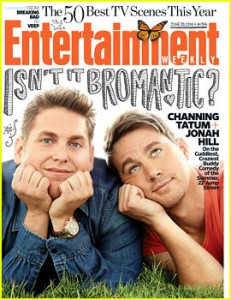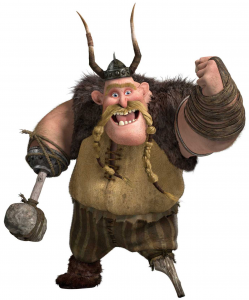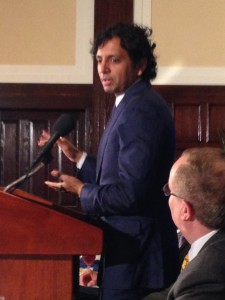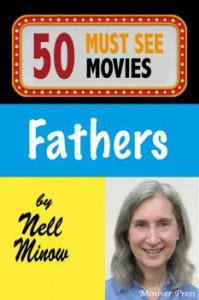Writer/director Dean DeBlois is one of my favorite people to interview and it was delightful to talk to him about the wonderful “How to Train Your Dragon 2.”
Just give me the basics just to set the stage. Tell me how much time has gone by since the first film and where we start off.
This is the second installment of a planned of trilogy. It has our characters now 20 years old instead of 15 year olds that were in our first movie. We wanted to introduce Hiccup and the gang at a different crossroads in their life where they are now stepping into adulthood with some uncertainty and a sense that Hiccup isn’t quite cut out to take over his father’s mantle as chief. So instead he is expressing his restlessness by being out there on the edge of the Viking map and charting new lands and finding new dragons. That’s where he comes across the conflict that actually threatens the peace back home. He discovers that there is a group of dragon trappers that are trapping dragons for an ambitious conqueror named Drago Bludvist who on plans on amassing a dragon army. And there is also a vigilante who is out there rescuing dragons and whisking them away to safety.
Now tell me a little bit about what has happened in the technology side since you made the first one and how that has affected making the movie. Were there things you were able to do this time that you couldn’t do last time?
Sure, absolutely! This film is actually the first to roll out a brand new generation of software that has been in development for over five years. And it just reinvents the way that we approach our work and makes it very intuitive and real time so that we don’t have to wait for renders which always impairs creativity. The big improvement is that the software is much faster so you can work with lots of characters on screen but the results are immediate and so animators now work with their hands again. They get to use the stylus and they can manipulate characters instead of using spreadsheets, numeric entries and pull-down menus.
It seems to me that there is a lot more capacity for many, many characters to interact with each other.
That’s exactly it! There are so many shots in this movie that increase the scope and scale which is perfect for our ambition for the film. There were shots that couldn’t have been done before, like where we have thousands of characters on screen rushing the beach and the epic battle of the second act or so many different characters riding their dragons even in the opening during the dragon races. It allows us to be really rich and complex and also allows for incredible subtlety with the animation as well because there is so much going on under the skin with every one of our character.
With every year it seems like technology makes our lives a little bit easier and makes things look a lot better. Five years ago it seems like clouds in particular were very difficult or water, or anything interacting with water was difficult, like ice for example. We have a lot of that in our movie and it was really difficult to light that but now they look spectacular and you can imagine actually what it going to be five years from now. I believe that what we’re doing now which feels very cutting edge five years from is going to look primitive in ten years.
There is a guy name Dave Walvoord who was our head of visual effects who spent a lot of time actually developing the look of that ice. And it really was incredible. They worked really hard, it was difficult but they figured out a formula that seems to allow just the right amount of light to reflect through it and it has just the right opacity and luminosity to it that just makes it jump off the screen. That’s hats off to our effects department, breathing so much life into what lurks beneath the waves has add a really great quality to it
 I’m going to try to do this so that we avoid spoilers but we lose an important character in this movie, so what can you say about that?
I’m going to try to do this so that we avoid spoilers but we lose an important character in this movie, so what can you say about that?
It was painful but it was a rite of passage and I think that we all knew that Hiccup had a place to go narratively and so long as he had a crutch he wouldn’t step into the role that he needed to step into. So as somebody who suffered a very similar loss as a boy it has a great heroism to it and a nobility to it but also narratively in terms of tracking Hiccup’s coming of age it was a rite of passage that I thought we needed to go through in order to really commit to the person he needed to become.
That was sad but what totally got me was that beautiful song. I cried. So tell me about the choreography and where the song came from.
I’m really happy to hear that because that was the moment I was most afraid of in the movie and as a result I’m maybe most proud of. The risk for a cringe-worthy experience was high I knew I wanted to have this old Viking ballad that would have been passed down through the generations and something that would have been sung at her wedding to bring her back from this place of regret and remorse and feeling overwhelmed by the realization that people can change and she made the wrong decision and all this time her son who probably needed her feeling like a square peg back in Berk, left to feel like he was the only one that was sympathetic to dragons.
So she is carrying a lot of that burden at the beginning of the scene and Hiccup is so enthusiastic, he’s unaware that he is only overwhelming her more but Stoick realizes that there is another approach and so he uses this song that was a duet to remind her of the person she used to be and who they used to be together. So it was made to be carried out in a very clumsy kind of charming way that used music minimally in order to feel authentic and raw and not a burst into song musical moment. And it sounds like we pulled it off if it made you cry.
I should tell you the song was actually written by Jónsi who was the frontman of an Icelandic band call Sigur Rós and he did our incredible song at the end of our first film. He’s a good friend and I made a concert film for them a few years ago. He joined forces with John Powell to write two pieces for this movie and that’s Hiccup’s introduction song and this song. Lyrically I had something very specific in mind. Shane McGowan from the Pogues has always written these really heartfelt tender beautiful moments and beautiful lyrics and so we approached him about it. He jumped at the chance so the lyrics are lyrics are actually from Shane McGowan, John Powell and Jónsi. We even brought in a choreographer to help us with the movements.
The choreography was pretty intricate.
Yes, we used a choreographer from Once, the stage production and America Idiot. I asked him to make it feel like your parents, sort of bumbling parents dancing around the kitchen instead of Dancing with the Stars. And he incorporated a few fumbles as well in the middle of the choreography to make it feel really authentic and unrehearsed.
I thought that was great. Now I want to go back to the beginning for a minute because that dragon race was an incredible way to get you very immediately into the film and with the characters. How do you orchestrate that to keep us on top of so many different things that are happening?
Narratively we had a lot of ground to cover just in terms of recapping it for the audience and helping out the audience who had not seen the first film. So we decided to do it this very kinetic visceral way. Now that the Vikings and dragons are no longer at each other’s throats they needed something to do with all that energy. so they created this obstacle race of sorts that involves finding marked sheep that are all over the island and then returning them to these baskets that contain them. And you have the whole populous of Berk crammed into these stands cheering them on. This way we could see all of our auxiliary cast aged five years later but also reintroduce them in a fun kinetic way paired with their dragons and seeing how they have become symbiotic flyers in these five years that has passed.
And then another thing is we fly be a lot of the updates that have been installed since the first movie so in places of catapults, and battle stations we now have feeding stations, water reservoir, and aqueducts. You can really see the ways that the dragons have been integrated into the Vikings’ daily lives and how it’s become a dragon utopia, which also helps to set up the stakes for the movie. This is what could be lost if Drago Bludvist has his way and conquers their land as well.
Drago is played by Djimon Hounsou. Tell me about selecting him for the cast and what you saw for that character.
One of my favourite movies is Blood Diamond and I thought Djimon was so powerful in that movie, in particular the scene where he is talking to his son who has been brainwashed by the warlords and has a gun pointed at his father. It’s this beautiful scene where he is saying, “This is who you are and these are your sisters and this is your mother” and remind him of sort of the daily life of who he used to be and the tears were running down his face. I thought that was a great reference for the moment where Hiccup was trying to reconnect with Toothless in the third act of the movie. So he was high on my list and I also love the fact that Djimon was born in Africa but raised in France and he has a very non specific accent which is what I wanted for this character. He was from a distant land, a strange land of unknown origin and so it added to his mystique that he is journeyed this long way for this goal of amassing a dragon army. He’s got a great character to his voice that’s really powerful and intimidating but also textured to indicate that there’s more going on than just the arch villain. He has limited screen time in this movie but I think there is a sense of wanting to know more about what makes him tick.
And I also really enjoyed the new character that you added, Eret played by Kit Harington.
I started watching Game of Thrones as I was setting up the movie and John Snow quickly became one of my favorite characters. And I loved that sense of youth in his voice, and there’s a nobility there. Eret is from a completely different land but also in a way a contemporary of Hiccup’s, roughly in that age range. There was a youth and a charm but also playfulness to the voice that Kit brings. And I actually think he did a great job of rising to the occasion because we pushed the character to be much more of an arrogant, cocksure, cowboy of a dragon trapper who loves the sound of his own voice and Kit immediately took to that and packed more accent to it to make it seem even more amplified. I think he had a lot of fun with the role.
What’s next?
I’m about to start writing that script after I take a little break. I have an existing outline already that was part of mapping the trilogy was kind of knowing what threads we would be drawing out of the first film and playing out in the second installment but then also what are we setting up for the third? I love the idea that something that Cressida Cowell had mentioned when she was visiting the studio and she is the author of the books from which the first movie was based. She said, “I plan by the end to explain what happens to dragons and why they are no more.” That was so compelling and I thought “Wow, it is such a powerful idea.” Of course it’s bittersweet but I think it is so emotionally powerful and fitting to be able to close a chapter on this trilogy with history returning to somewhat as we know it and what happened to the dragons and where did they go and could they come back. These are all mysteries that will be unveiled. But I loved that Hiccup learned stand on his own and made the toughest decisions of all for the betterment of mankind and dragons.






